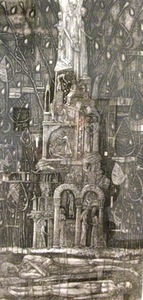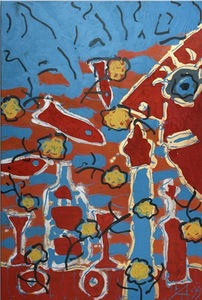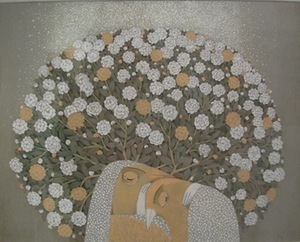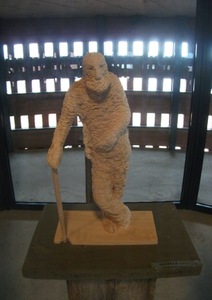ABOUT SEVERAL EXHIBITION OR HOW TO AVOID DESERTS 0
In brief: There is more and more light in Kaunas exhibition halls now presenting the classical graphics of Egidijus Rudinskas (‘Graphics 1982-2012’, Kaunas Picture Gallery), authentically spiritual works of Albina Žiupsnytė (‘Longing for the God’s Land’, Balta Gallery), sculptures of Leonas Strioga (‘Sons of Motherland shall Rise...’, Kaunas Castle), experiments of the ceramic ‘Spring’ show, conceptual ideas of Agnė Deveikytė-Liškauskienė, Jovita Aukštikalnytė-Varkulevičienė and Saulius Paliukas (‘Non-Painting’, Meno Parkas Gallery) and the painting duet of a father and son – both Vytautas Povilaitis (‘Duets’, Aukso Pjūvis Gallery).
***
A retrospective exhibition of thirty years by the graphic artist E. Rudinskas reveals his love to tradition, history and imagination. The old archetypes, medieval stories full of real and imaginary things and meaningful symbols make one stop, look and listen. The artist creates his world like a virtuoso, using the techniques of etching and aquatint. His works are characteristic of precise forms, masterly drawing, humane contents and nearly sacred moods. They are always sensitive, sometimes elegant and constantly radiating inner light. Everything looks so simple but simplicity is often forgotten in the vortex of daily haste, anxiety and worries. Do adults dream and what about? Do they start a journey across fantasised cities? One cannot avoid it in E. Rudinskas’s show.
***
The painting of Vytautas Povilaitis Sr (1927-2009) and Vytautas Povilaitis Jr (born 1970) is rediscovered at the ‘Duets’ show at the Aukso Pjūvis Gallery. Works of both artists, created by 2003, are presented in the display. V. Povilaitis Sr is often called the pioneer of the Lithuanian abstraction. Yet he was not recognised at his time: pseudo canons of social realism did not let modernist thinking into the exhibition halls. Since a conflict with the ideology could seriously harm his career, Povilaitis presented his abstract paintings as projects for textile fabrics and tapestries.
His son also became interested in the world of art. He would watch his father paint landscapes in the nature and later started to paint himself. The similarities between the works of the father and son are rather external than inner. Povilaitis Sr never controlled Povilaitis Jr nor enforced any canons or rules.
***
Albina Žiupsnytė’s ‘Longing for the God’s Land’ fills Balta Gallery with a sacred spirit. Topics of nature and belief are dominant in the artist’s work. Religious motifs are unfolded by symbols and metaphoric images in the exhibition. In order to narrate about the longing for God, the artist continues the subject of golden cities, blossoming animals and the secret of eternity. Another part of the display is dedicated to the composer and artist M. K. Čiurlionis. Touching his personality became a particular spiritual collaboration for A. Žiupsnytė.
***
Twenty five sculptures created by the sculptor Leonas Strioga wait for viewers at Kaunas Castle Tower. The works made in an original technique of chopping meet visitors meekly and proudly at the same time. The author was always interested in the nation and their past. His show is called ‘Sons of the Motherland shall Rise...’ – a line from the poem of the famous Lithuanian poet Maironis. The historical past of the nation is revealed in lyrical forms and an original interpretation of tradition and modernity. Everything irrelevant, artificial or temporary is sifted out in front of L. Strioga’s sculptures. Only simplicity, a silent witness of the meaning of being, a statement of the joy of life and soft melancholia remain.
***
Works of three young painters - Agnė Deveikytė-Liškauskienė, Jovita Aukštikalnytė-Varkulevičienė and Saulius Paliukas – are displayed at the Meno Parkas Gallery, the ‘Non-Painting’ exhibition. The display emphasises the artists’ experiments pursued in parallel with their painting.
S. Paliukas reveals his interests in the interpretation of time-flow, experiences in time and historical signs. A. Deveikytė focuses on a line left in the paper by a sewing machine. According to the author, it can be various – the line of life, air, history, conveyor, horizon, front etc. At the meantime, J. Aukštikalnytė chooses drawing and paper cutting as a means to record ideas equal to painting. The artist uses elements of landscape and portrait but does not elaborate the chosen motifs, just highlights their silhouettes and fragments.













